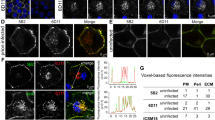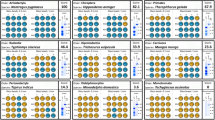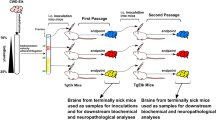Abstract
Much evidence supports the hypothesis that the infectious agents of prion diseases are devoid of nucleic acid, and instead are composed of a specific infectious protein1. This protein, PrPSc, seems to be generated by template-induced conformational change of a normally expressed glycoprotein, PrPC (ref. 2). Although numerous studies have established the conversion of PrPC to PrPSc as the central pathogenic event of prion disease, it is unknown whether cellular factors other than PrPC might be required to stimulate efficient PrPSc production. We investigated the biochemical amplification of protease-resistant PrPSc-like protein (PrPres) using a modified version3 of the protein-misfolding cyclic amplification method4. Here we report that stoichiometric transformation of PrPC to PrPres in vitro requires specific RNA molecules. Notably, whereas mammalian RNA preparations stimulate in vitro amplification of PrPres, RNA preparations from invertebrate species do not. Our findings suggest that host-encoded stimulatory RNA molecules may have a role in the pathogenesis of prion disease. They also provide a practical approach to improve the sensitivity of diagnostic techniques based on PrPres amplification.
This is a preview of subscription content, access via your institution
Access options
Subscribe to this journal
Receive 51 print issues and online access
$199.00 per year
only $3.90 per issue
Buy this article
- Purchase on Springer Link
- Instant access to full article PDF
Prices may be subject to local taxes which are calculated during checkout




Similar content being viewed by others
References
Prusiner, S. B. Novel proteinaceous infectious particles cause scrapie. Science 216, 136–144 (1982)
Prusiner, S. B. (ed.) Prion Biology and Diseases (Cold Spring Harbor Laboratory Press, Cold Spring Harbor, New York, 1999)
Lucassen, R., Nishina, K. & Supattapone, S. In vitro amplification of protease-resistant prion protein requires free sulfhydryl groups. Biochemistry 42, 4127–4135 (2003)
Saborio, G. P., Permanne, B. & Soto, C. Sensitive detection of pathological prion protein by cyclic amplification of protein misfolding. Nature 411, 810–813 (2001)
Lockard, R. E. & Kumar, A. Mapping tRNA structure in solution using double-strand-specific ribonuclease V1 from cobra venom. Nucleic Acids Res. 9, 5125–5140 (1981)
Banks, G. R. A ribonuclease H from Ustilago maydis. Properties, mode of action and substrate specificity of the enzyme. Eur. J. Biochem. 47, 499–507 (1974)
Kocisko, D. A. et al. Cell-free formation of protease-resistant prion protein. Nature 370, 471–474 (1994)
Caughey, B., Horiuchi, M., Demaimay, R. & Raymond, G. J. Assays of protease-resistant prion protein and its formation. Methods Enzymol. 309, 122–133 (1999)
Derrington, E. et al. PrPC has nucleic acid chaperoning properties similar to the nucleocapsid protein of HIV-1. C. R. Acad. Sci. III 325, 17–23 (2002)
Moscardini, M. et al. Functional interactions of nucleocapsid protein of feline immunodeficiency virus and cellular prion protein with the viral RNA. J. Mol. Biol. 318, 149–159 (2002)
Gabus, C. et al. The prion protein has RNA binding and chaperoning properties characteristic of nucleocapsid protein NCP7 of HIV-1. J. Biol. Chem. 276, 19301–19309 (2001)
Gabus, C. et al. The prion protein has DNA strand transfer properties similar to retroviral nucleocapsid protein. J. Mol. Biol. 307, 1011–1021 (2001)
Nandi, P. K., Leclerc, E., Nicole, J. C. & Takahashi, M. DNA-induced partial unfolding of prion protein leads to its polymerisation to amyloid. J. Mol. Biol. 322, 153–161 (2002)
Cordeiro, Y. et al. DNA converts cellular prion protein into the β-sheet conformation and inhibits prion peptide aggregation. J. Biol. Chem. 276, 49400–49409 (2001)
Weissmann, C. A ‘unified theory’ of prion propagation. Nature 352, 679–683 (1991)
Chapon, C., Cech, T. R. & Zaug, A. J. Polyadenylation of telomerase RNA in budding yeast. RNA 3, 1337–1351 (1997)
Acknowledgements
The authors thank G. Saborio, C. Soto, V. Ambros, C. Cole and W. Wickner for helpful advice. This work was supported by the Burroughs Wellcome Fund Career Development Award, the Hitchcock Foundation, and an NIH Clinical Investigator Development Award.
Author information
Authors and Affiliations
Corresponding author
Ethics declarations
Competing interests
The authors declare that they have no competing financial interests.
Rights and permissions
About this article
Cite this article
Deleault, N., Lucassen, R. & Supattapone, S. RNA molecules stimulate prion protein conversion. Nature 425, 717–720 (2003). https://doi.org/10.1038/nature01979
Received:
Accepted:
Issue Date:
DOI: https://doi.org/10.1038/nature01979
This article is cited by
-
Propagation of PrPSc in mice reveals impact of aggregate composition on prion disease pathogenesis
Communications Biology (2023)
-
Therapeutic development of polymers for prion disease
Cell and Tissue Research (2023)
-
Understanding the key features of the spontaneous formation of bona fide prions through a novel methodology that enables their swift and consistent generation
Acta Neuropathologica Communications (2023)
-
Generation of human chronic wasting disease in transgenic mice
Acta Neuropathologica Communications (2021)
Comments
By submitting a comment you agree to abide by our Terms and Community Guidelines. If you find something abusive or that does not comply with our terms or guidelines please flag it as inappropriate.



